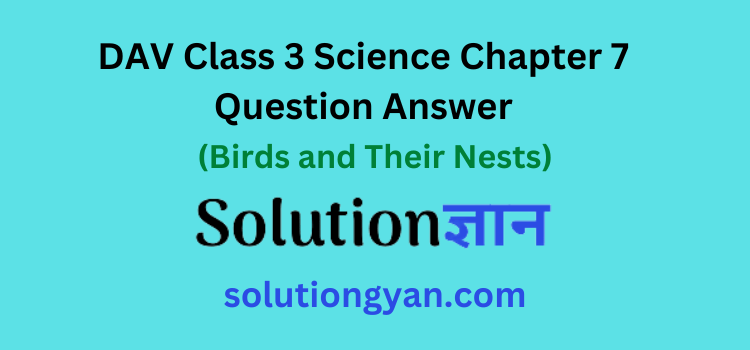DAV Class 3 Science Chapter 7 Question Answer Birds and Their Nests are prepared by Science subject experts. With the help of these solutions for Class 3 Science My Living World Book, you can easily grasp basic concepts better and faster.
Here at SOLUTIONGYAN, chapter 7 Birds and Their Nests of class 3 Science book exercise provided at the end of the chapter will be a useful resource for DAV Class 3 students.
Here, we provide complete solutions of DAV Class 3 Science Chapter 7 Birds and Their Nests of My Living World Textbook. These exercise of chapter 7 contains 5 questions and the answers to them are provided in the DAV Class 3 Science Chapter 7 Question Answer.

DAV Class 3 Science Chapter 7 Birds and Their Nests Solutions
DAV Class 3 Science Chapter 7 Birds and Their Nests Solutions is given below. Here DAV Class 3 Science chapter 7 question answer is provided with detailed explanation.
Highlights
- Fill in the blanks
- Write True or False
- Tick the correct option
- Answer the following questions in brief
- Answer the following questions
DAV Class 3 students are more likely to score good marks in Science exam if they practise DAV Class 3 Science Chapter 7 Question Answer regularly.
DAV Class 3 Science Chapter 7 Question Answer
A. Fill in the blanks.
1. The sparrow makes a nest between the ___________ of a tree.
2. Birds make nests to lay their ___________.
3. In case of weaver bird it is the ___________ who makes the nest.
4. Some animals, sometimes, break the ___________ of birds.
5. Birds ___________ their young ones from other animals.
Answer: (1) branches (2) eggs (3) male (4) nest (5) protect
B. Write True or False for the following statements.
1. Different birds have different nesting habits.
2. A crow builds its nest on the ground.
3. Beaks and claws help birds to catch their food.
4. The sunbird does not make any nest of its own.
5. We should never break the nest of a bird.
Answer: (1) True (2) False (3) True (4) False (5) True
C. Tick the correct option.
1. Birds can fly because they have-
Answer: hollow light bones
2. The bird that makes a tuk-tuk sound, while making its nest in a tree trunk, is-
Answer: barbet or coppersmith
3. Birds are usually busy making nests during the month of-
Answer: April
4. This bird uses stones and pebbles to make its nest.
Answer: penguin
5. This bird migrates to India during winters.
Answer: Siberian crane
D. Answer the following questions in brief.
1. Name three birds who work in pairs to make their nests.
Answer: Sparrow, Sunbird and Dove work in pair to make their nests.
2. Why are birds called as aerial animals?
Answer: Birds can fly in air therefore they are called as aerial animals.
3. List some materials that are used by various birds to make their nests.
Answer: Materials like twigs, straws, leaves, grass, small wooden pieces, cotton & feathers etc.
4. When, and where, does a barbet make its nest?
Answer: In summer, barbet makes its nest in the holes of tree trunk.
5. List some places where we find birds’ nests.
Answer: We can find bird’s nest on a tree, on terraces of a buildings, on electricity poles etc.
E. Answer the following questions.
1. Write any three features of birds that help them to fly.
Answer: Birds can easily fly in air because they have–
- Hollow bones, which make their body light.
- Wings that are made up of light feathers.
- Pointed, sharp, boat shaped body.
2. How are nests useful for birds?
Answer: Nests are useful for bird’s because:
- They lay eggs and hatch them.
- They keep their young ones safe and warm.
- Their chicks stay there, till they are old enough to fly.
3. How does a tailor bird make its nest?
Answer: The tailor bird stitches the leaves with the help of its beak using small twigs as thread to make its nest.
4. What do you mean by migration of birds? Name any two migratory birds.
Answer: Some birds live in very cold regions. But it is difficult to find food and to tolerate the very low temperature of these regions in winters. So, they fly to warmer areas during the winters. This is known as migration.
Example: Siberian crane and flamingo.

Thank sir your answer is very helpful for us